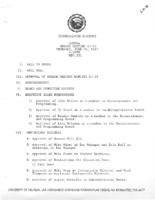Search the Special Collections and Archives Portal
Search Results
Frances Intravia Photograph Collection
Identifier
Abstract
The Frances Intravia Photograph Collection (approximately 1948 to 1979) contains three black-and-white photographic prints. The images depict Albert and Arabell Lee Hafner, author of 100 Years on the Muddy, visiting the St. Thomas, Nevada townsite after the Lake Mead water levels dropped enough make it visible. One of the prints is an original from approximately 1948 to 1952, and the other two are reproductions of images taken during the same period.
Archival Collection
Fraley Family Collection of Las Vegas, Nevada Films and Photographs
Identifier
Abstract
The Fraley Family Collection of Las Vegas, Nevada Films and Photographs (1956-1995) include 8mm photographic films of the Helldorado Parade and Hoover (Boulder) Dam in 1956, color photographic prints of the construction of the Fremont Street Experience in 1995, and one color photographic print of the Tower Casino at the State Line in 1976. The 8mm film footage was taken during a family vacation and also includes exterior shots of casinos on the Las Vegas Strip.
Archival Collection
Lincoln County Archaeological Initiative Collection
Identifier
Abstract
The Lincoln County Archaeological Initiative Collection (2016-2019) contains digital files of oral histories collected as part of A Ranching and Farming Context for Lincoln County, Nevada, ca. 1857 to 1934 (Oliver et al. 2018). The collection consists of thirteen digital oral history recordings and corresponding transcripts, as well as a final report of phase one of the project. The entire collection is digital files.
Archival Collection
Victor J. Zerga oral history interview
Identifier
Abstract
Oral history interview with Victor J. Zerga conducted by David Jukich on April 03, 1976 for the Ralph Roske Oral History Project on Early Las Vegas. Zerga gives insight into the field of nursing and discusses the role that ranching had in Las Vegas, Nevada.
Archival Collection
Marcus Mason oral history interview
Identifier
Abstract
Oral history interview with Marcus Mason conducted by Leon Green on February 04, 2013 for the African Americans in Las Vegas: a Collaborative Oral History Project. Mason talks about his childhood in Las Vegas, Nevada, his parents’ past occupations, and how his religious upbringing influenced his career choices as an adult.
Archival Collection

Interview with Leslie Ray Hill, February 17, 2006
Date
Archival Collection
Description
Text

David Ober interview, October 11, 2017: transcript
Date
Archival Collection
Description
Tucson, Arizona, native David Ober moved to Las Vegas twice. He arrived reluctantly the first time in 1978 with his parents as a high-school student, when his father, Hal Ober, came to Las Vegas to begin building and marketing the U.S. Home (now Lennar) brand. While the elder Ober soon left U.S. Home to open his own home-building business, R.A. Homes, his youngest child left Las Vegas shortly after his high school graduation to return to his native Tucson, follow in the footsteps of his siblings, and attend the University of Arizona. After graduating from the University of Arizona David Ober opened his own mortgage company and began building a life in Phoenix. In the late 1980s he agreed to take a large pay cut, return to Las Vegas, and learn his father's business from the ground up. At the time, Hal Ober was developing his award-winning, master-planned community, Desert Shores. David Ober, the youngest of the five children of Hal and D'Vorre (Dee) Ober, agreed to participate in the
Text

Meeting minutes for Consolidated Student Senate University of Nevada, Las Vegas, June 18, 1987
Date
Archival Collection
Description
Text

Meeting minutes for Consolidated Student Senate, University of Nevada, Las Vegas, December 03, 2007
Date
Archival Collection
Description
Text

Meeting minutes for Consolidated Student Senate University of Nevada, Las Vegas, September 29, 1997
Date
Archival Collection
Description
Text
